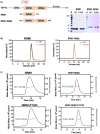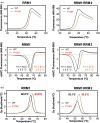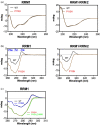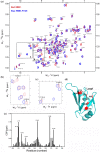Frontotemporal dementia-linked P112H mutation of TDP-43 induces protein structural change and impairs its RNA binding function
- PMID: 33151007
- PMCID: PMC7784771
- DOI: 10.1002/pro.3990
Frontotemporal dementia-linked P112H mutation of TDP-43 induces protein structural change and impairs its RNA binding function
Abstract
TDP-43 forms the primary constituents of the cytoplasmic inclusions contributing to various neurodegenerative diseases, including amyotrophic lateral sclerosis and frontotemporal dementia (FTD). Over 60 TDP-43 mutations have been identified in patients suffering from these two diseases, but most variations are located in the protein's disordered C-terminal glycine-rich region. P112H mutation of TDP-43 has been uniquely linked to FTD, and is located in the first RNA recognition motif (RRM1). This mutation is thought to be pathogenic, but its impact on TDP-43 at the protein level remains unclear. Here, we compare the biochemical and biophysical properties of TDP-43 truncated proteins with or without P112H mutation. We show that P112H-mutated TDP-43 proteins exhibit higher thermal stability, impaired RNA-binding activity, and a reduced tendency to aggregate relative to wild-type proteins. Near-UV CD, 2D-nuclear-magnetic resonance, and intrinsic fluorescence spectrometry further reveal that the P112H mutation in RRM1 generates local conformational changes surrounding the mutational site that disrupt the stacking interactions of the W113 side chain with nucleic acids. Together, these results support the notion that P112H mutation of TDP-43 contributes to FTD through functional impairment of RNA metabolism and/or structural changes that curtail protein clearance.
Keywords: RNA recognition motif; RNA-binding protein; neurodegenerative disease; protein aggregation.
© 2020 The Authors. Protein Science published by Wiley Periodicals LLC on behalf of The Protein Society.
Figures








Similar articles
-
Pathological Mutations D169G and P112H Electrostatically Aggravate the Amyloidogenicity of the Functional Domain of TDP-43.ACS Chem Neurosci. 2024 Dec 4;15(23):4267-4283. doi: 10.1021/acschemneuro.4c00372. Epub 2024 Nov 18. ACS Chem Neurosci. 2024. PMID: 39558635
-
Folding of the RNA recognition motif (RRM) domains of the amyotrophic lateral sclerosis (ALS)-linked protein TDP-43 reveals an intermediate state.J Biol Chem. 2014 Mar 21;289(12):8264-76. doi: 10.1074/jbc.M113.542779. Epub 2014 Feb 4. J Biol Chem. 2014. PMID: 24497641 Free PMC article.
-
A novel mutation P112H in the TARDBP gene associated with frontotemporal lobar degeneration without motor neuron disease and abundant neuritic amyloid plaques.Acta Neuropathol Commun. 2015 Apr 3;3:19. doi: 10.1186/s40478-015-0190-6. Acta Neuropathol Commun. 2015. PMID: 25853458 Free PMC article.
-
TDP-43 and FUS in amyotrophic lateral sclerosis and frontotemporal dementia.Lancet Neurol. 2010 Oct;9(10):995-1007. doi: 10.1016/S1474-4422(10)70195-2. Lancet Neurol. 2010. PMID: 20864052 Review.
-
Phase to Phase with TDP-43.Biochemistry. 2017 Feb 14;56(6):809-823. doi: 10.1021/acs.biochem.6b01088. Epub 2017 Jan 30. Biochemistry. 2017. PMID: 28112502 Review.
Cited by
-
Expanding the TDP-43 Proteinopathy Pathway From Neurons to Muscle: Physiological and Pathophysiological Functions.Front Neurosci. 2022 Feb 3;16:815765. doi: 10.3389/fnins.2022.815765. eCollection 2022. Front Neurosci. 2022. PMID: 35185458 Free PMC article. Review.
-
RNA-binding deficient TDP-43 drives cognitive decline in a mouse model of TDP-43 proteinopathy.Elife. 2023 Oct 11;12:RP85921. doi: 10.7554/eLife.85921. Elife. 2023. PMID: 37819053 Free PMC article.
-
Mechanisms of TDP-43 Proteinopathy Onset and Propagation.Int J Mol Sci. 2021 Jun 2;22(11):6004. doi: 10.3390/ijms22116004. Int J Mol Sci. 2021. PMID: 34199367 Free PMC article. Review.
-
Elevated nuclear TDP-43 induces constitutive exon skipping.Mol Neurodegener. 2024 Jun 9;19(1):45. doi: 10.1186/s13024-024-00732-w. Mol Neurodegener. 2024. PMID: 38853250 Free PMC article.
-
Nuclear-import receptors as gatekeepers of pathological phase transitions in ALS/FTD.Mol Neurodegener. 2024 Jan 22;19(1):8. doi: 10.1186/s13024-023-00698-1. Mol Neurodegener. 2024. PMID: 38254150 Free PMC article. Review.
References
-
- Vanden Broeck L, Callaerts P, Dermaut B. TDP‐43‐mediated neurodegeneration: Towards a loss‐of‐function hypothesis? Trends Mol Med. 2014;20:66–71. - PubMed
Publication types
MeSH terms
Substances
LinkOut - more resources
Full Text Sources

